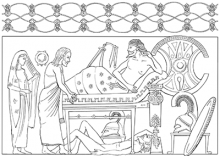
You are here
Episode 10: The Pity of Achilles
Story summary
Teaching activities
- Starting points
- Follow-up
- Further activities
-
Begin with asking learners to retell the previous episode. Make use of any note-taking they did last time. Assign some time to look at their notes, then ask them to retell this episode unaided. After hearing one or two versions, discuss any difficulties they had and the differences in the retellings.
-
Talk about the title of this episode and ask the class who Achilles might have pity for.
-
Discuss the story so far. What predictions would they make? Ask them to discuss how they think the story could and will end.
-
Tell the group to listen for a new character in this episode. Ask them to guess who it might be. If you are keeping a family tree, make sure that Polyxena is correctly placed as Priam’s daughter, a princess of Troy.
-
There is a vivid description of the terrible journey made by Priam and Polyxena. Replay "In the enemy camp" or read it to the class and ask them to imagine being one of those two Trojans. What do they pass? What are they feeling? For some learners a copy of the
![[pdf] [pdf]](/sites/default/files/pdf_icon.png) transcript (pp. 1-2) would help.
transcript (pp. 1-2) would help. -
There is an opportunity here to discuss the bravery of a young woman and the role of women in the story. Girls particularly might be glad of the chance to discuss their opinions about Polyxena, and whether they identify with her.
-
It is possible here to introduce poetry written at the time of the First or Second World Wars. You could also show paintings and/or photographs, particularly of the trenches in the First World War — reminiscent of the description of the plain of Troy. Use these to help learners draw or paint the scene that Priam and Polyxena pass through. You will need to handle this activity carefully. Ensure that they research thoroughly and that their rendering of the scene is accurate — not an excuse gratuitously to depict violence.
-
Why does Achilles take pity on King Priam? (Priam reminds him of his own father and he realises that Peleus, like Priam, will soon feel the terrible loss of a son.)
-
What does Achilles mean when he refers to “the grieving smoke”? (The smoke from Hector’s funeral pyre.)
-
Who also takes pity on Priam and why should he do this? (Apollo when he restores Hector. He has always loved Troy because Priam made many offerings to him.)
-
Show the class the illustration,
![[pdf] [pdf]](/sites/default/files/pdf_icon.png) Priam and Achilles. Who do they think the figure on the left is? (The class will probably say Polyxena, but it is in fact Briseis, who has been restored to Achilles.) How well has the artist captured the scene? (Achilles lies on a couch over the body of Hector, reflecting his victory; but Hector’s pose is not unlike that of Achilles, hinting at the similarity of their fates.)
Priam and Achilles. Who do they think the figure on the left is? (The class will probably say Polyxena, but it is in fact Briseis, who has been restored to Achilles.) How well has the artist captured the scene? (Achilles lies on a couch over the body of Hector, reflecting his victory; but Hector’s pose is not unlike that of Achilles, hinting at the similarity of their fates.) -
Polyxena uses her ring to pay for her brother’s body. How does Achilles repay her? (He gives her the ring that he had given Patroclus.)
-
Achilles, in a sombre mood, says to Priam that the gods “who know no care have woven sorrow into the pattern of our lives.” (
![[pdf] [pdf]](/sites/default/files/pdf_icon.png) Transcript p. 3.) Ask learners if they know what he means. Do they think that, if Achilles were alive today, he would think the same thing?
Transcript p. 3.) Ask learners if they know what he means. Do they think that, if Achilles were alive today, he would think the same thing?
How do learners feel about Polyxena? Should she have accepted the ring? Do they think that it is possible/right to love someone who has killed your brother?
Visual aids
Priam and Achilles
Based on an amphora, c. 540 BC. Staatliche Kunstsammlungen, Kassel.
Priam stretches out his hands towards the body of Hector, who is lying as if asleep. Behind Priam stands Briseis with her veil pulled aside as a mark of respect. Achilles lies on a couch above Hector, his hand pointing downwards, perhaps to indicate that he is willing to return Hector’s body to the Trojans for formal burial.
